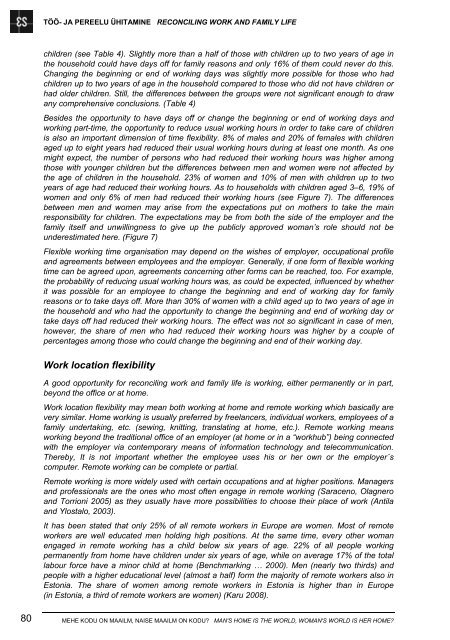MEHE KODU ON MAAILM, NAISE MAAILM ON KODU? - Tartu Ãlikool
MEHE KODU ON MAAILM, NAISE MAAILM ON KODU? - Tartu Ãlikool
MEHE KODU ON MAAILM, NAISE MAAILM ON KODU? - Tartu Ãlikool
You also want an ePaper? Increase the reach of your titles
YUMPU automatically turns print PDFs into web optimized ePapers that Google loves.
TÖÖ- JA PEREELU ÜHITAMINE REC<strong>ON</strong>CILING WORK AND FAMILY LIFE<br />
children (see Table 4). Slightly more than a half of those with children up to two years of age in<br />
the household could have days off for family reasons and only 16% of them could never do this.<br />
Changing the beginning or end of working days was slightly more possible for those who had<br />
children up to two years of age in the household compared to those who did not have children or<br />
had older children. Still, the differences between the groups were not significant enough to draw<br />
any comprehensive conclusions. (Table 4)<br />
Besides the opportunity to have days off or change the beginning or end of working days and<br />
working part-time, the opportunity to reduce usual working hours in order to take care of children<br />
is also an important dimension of time flexibility. 8% of males and 20% of females with children<br />
aged up to eight years had reduced their usual working hours during at least one month. As one<br />
might expect, the number of persons who had reduced their working hours was higher among<br />
those with younger children but the differences between men and women were not affected by<br />
the age of children in the household. 23% of women and 10% of men with children up to two<br />
years of age had reduced their working hours. As to households with children aged 3–6, 19% of<br />
women and only 6% of men had reduced their working hours (see Figure 7). The differences<br />
between men and women may arise from the expectations put on mothers to take the main<br />
responsibility for children. The expectations may be from both the side of the employer and the<br />
family itself and unwillingness to give up the publicly approved woman’s role should not be<br />
underestimated here. (Figure 7)<br />
Flexible working time organisation may depend on the wishes of employer, occupational profile<br />
and agreements between employees and the employer. Generally, if one form of flexible working<br />
time can be agreed upon, agreements concerning other forms can be reached, too. For example,<br />
the probability of reducing usual working hours was, as could be expected, influenced by whether<br />
it was possible for an employee to change the beginning and end of working day for family<br />
reasons or to take days off. More than 30% of women with a child aged up to two years of age in<br />
the household and who had the opportunity to change the beginning and end of working day or<br />
take days off had reduced their working hours. The effect was not so significant in case of men,<br />
however, the share of men who had reduced their working hours was higher by a couple of<br />
percentages among those who could change the beginning and end of their working day.<br />
Work location flexibility<br />
A good opportunity for reconciling work and family life is working, either permanently or in part,<br />
beyond the office or at home.<br />
Work location flexibility may mean both working at home and remote working which basically are<br />
very similar. Home working is usually preferred by freelancers, individual workers, employees of a<br />
family undertaking, etc. (sewing, knitting, translating at home, etc.). Remote working means<br />
working beyond the traditional office of an employer (at home or in a “workhub”) being connected<br />
with the employer via contemporary means of information technology and telecommunication.<br />
Thereby, It is not important whether the employee uses his or her own or the employer´s<br />
computer. Remote working can be complete or partial.<br />
Remote working is more widely used with certain occupations and at higher positions. Managers<br />
and professionals are the ones who most often engage in remote working (Saraceno, Olagnero<br />
and Torrioni 2005) as they usually have more possibilities to choose their place of work (Antila<br />
and Ylostalo, 2003).<br />
It has been stated that only 25% of all remote workers in Europe are women. Most of remote<br />
workers are well educated men holding high positions. At the same time, every other woman<br />
engaged in remote working has a child below six years of age. 22% of all people working<br />
permanently from home have children under six years of age, while on average 17% of the total<br />
labour force have a minor child at home (Benchmarking … 2000). Men (nearly two thirds) and<br />
people with a higher educational level (almost a half) form the majority of remote workers also in<br />
Estonia. The share of women among remote workers in Estonia is higher than in Europe<br />
(in Estonia, a third of remote workers are women) (Karu 2008).<br />
80<br />
<strong>MEHE</strong> <strong>KODU</strong> <strong>ON</strong> <strong>MAAILM</strong>, <strong>NAISE</strong> <strong>MAAILM</strong> <strong>ON</strong> <strong>KODU</strong>? MAN'S HOME IS THE WORLD, WOMAN'S WORLD IS HER HOME?

















